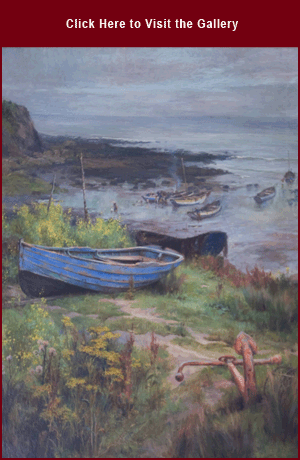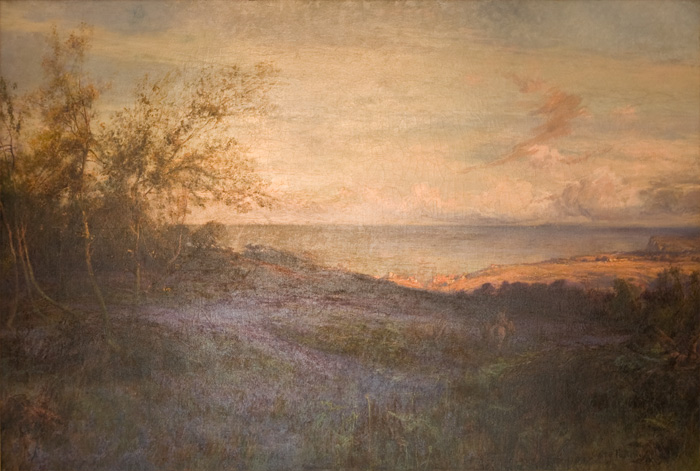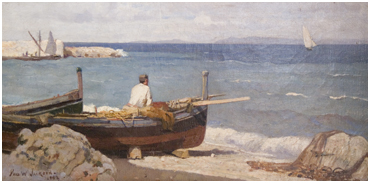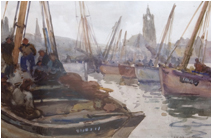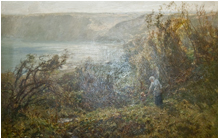A Brief History...
The Staithes Group 1894 - 1909
Painting at Staithes was pioneered by Gilbert Foster, who along with Fred Jackson and Mark Senior had been working in the area from around 1880. For the next thirty years the Yorkshire Coastline became the focal point for over thirty artists who were to come together as the Staithes Group. It was never an artist’s colony as it was at Newlyn; there was no one figure as pivotal as Stanhope Forbes and the group lacked that Bohemian element which was fundamental at Newlyn. Staithes was a coming together of artists whose individual and collective ambition was to depict contemporary life and to move away from the rigid disciplines of the establishment. This coming together lasted only fifteen years from 1894 to 1909.
The advent of the railway in 1883 brought more painters into the Staithes area; Spence Ingall rented a property at Hinderwell; by 1889 Ernest Dade was established in Scarborough; in 1890 Hannah Hoyland was in Staithes and was subsequently joined by her future husband Fred Mayor; in 1892 Isa Jobling visited Staithes and after her marriage in 1903 to the Newcastle painter Robert Jobling persuaded him to forego painting trips to Cullercoats in favour of Staithes. Other artists to visit at this time included Joseph Richard Bagshawe, James William Booth, Arthur Friedenson, Rowland Hill, Henry Silkstone Hopwood and Ernest Higgins Rigg.
In 1897 the visitors included Harold Knight and Laura Johnson. Both were students at the Nottingham School of Art. Laura had enrolled in 1890 at the age of thirteen, Harold who was three years her senior had already established a reputation as an outstanding student. Thomas Barrett, a master at Nottingham School of Art, owned a cottage at Staithes and suggested to Laura that it provided a splendid place to paint. And so for a month in 1897 they went to Staithes in the company of Laura’s aunt. The following year Harold and Laura returned to Staithes and were to make it their home until 1907. Laura’s reaction to Staithes is described in Oil Paint and Grease Paint:
“Staithes…. It was there that I found myself and what I might do. The life and place were what I yearned for – the freedom, the austerity, the savagery, the wilderness. I loved the cold and the northerly storms when no covering would protect you. I loved the strange race of people who lived there, whose stern almost forbidding exterior formed such contrasts to the warmth and richness of their nature.”
For the next fifteen years Staithes, along with Newlyn, played host to artists of international stature and witnessed the move from realism to impressionism. The period from 1901 to 1907 was the most productive and coincided with the formation of the Staithes Art Club. Prior to 1901 artists of the Staithes Group had exhibited with the Yorkshire Union of Artists; this had been formed in 1887 and both Ernest Rigg and Rowland Hill had been elected to the council of the Union. In 1901 the Staithes Group broke away from the Yorkshire Union of Artists and decided to hold their own exhibition at the Fishermen’s Institute in Staithes. No records have survived of this first exhibition and no critique was offered by the Whitby Gazette; however it was sufficiently successful for a committee to be formed charged with organising the 1902 exhibition to be held at the Fishermen’s Institute in August. The committee elected Silkstone Hopwood (chairman) and Richard Bagshawe (secretary); also present were Thomas Barrett, John Bowman, Ernest Dade, Arthur Friedenson, Rowland Hill, Hannah Hoyland, Spence Ingall, Fred Jackson, Isa Jobling, Laura Johnson, Harold Knight, Charles Hodge Mackie, Frank Mason, Fred Mayor, Ernest Rigg, Albert Stevens and Mark Senior. The 1902 exhibition was a success and this time the Whitby Gazette published a comprehensive review. An entrance fee was levied and the proceeds given to the Fishermen’s Institute. The 1903 exhibition was also held at Staithes; in 1904 the exhibition moved to the Anderson Gallery in Whitby as it had outgrown the Fishermen’s Institute. Edward Anderson had been elected a member of the Staithes Art Club in 1904 and the gallery in Whitby belonged to his father. This was to be the last independent exhibition; from 1905 until the Staithes Art Club disbanded in 1907, the exhibitions were absorbed into the annual exhibitions of the Yorkshire Union of Artists. The success of the Staithes Group led to it own demise. There was no location large enough to handle the increasing number of canvases and exhibitions in August clashed with the Summer Exhibition at the Royal Academy. Finally there was a limit to the number of wealthy patrons in the North East, not enough to sustain the ambitions of painters who were eagerly seeking fresh horizons. After 1907 the group disbanded and the artists went their separate ways. Fred Jackson, Mark Senior, Rowland Hill and Albert Stevens continued to work in the Staithes area,but others drifted away. Ernest Dade and the Mayors moved to London, Friedenson to Dorset and Hopwood to France. In 1907 Harold and Laura Knight decided to join Stanhope Forbes in Newlyn. They had first been introduced to the work of the Newlyn School whilst still at Nottingham School of Art. In 1894 they had seen an exhibition of the Newlyn Painters at the Nottingham Castle Museum. It was a tremendous wrench described by Laura in Oil Paint and Grease Paint: “Staithes had been one of the most vital influences in my life. To turn away from all that it had meant, fearing never to return, hurt me terribly. I hated leaving the moorland and the North Sea, the struggle that made you strong, the wild race of fisher people I loved so well. It was there that I had found what I might do.” During this period the artists had been accepted by the fisherfolk of Staithes and had been absorbed into the fabric of the village. They had shared the hardship wrought by the sea, they had grieved at its senseless taking and had shared in the joys of a tight knit community. Their presence had supplemented an ailing economy. There were lodgings to be paid for, studios to rent and models to hire. It was an unlikely partnership cemented by a mutual respect.
Artists continued to paint in Staithes but the impetus had gone and the Staithes Art Club was once again incorporated with the Yorkshire Union of Artists.
Peter Haworth 2002
